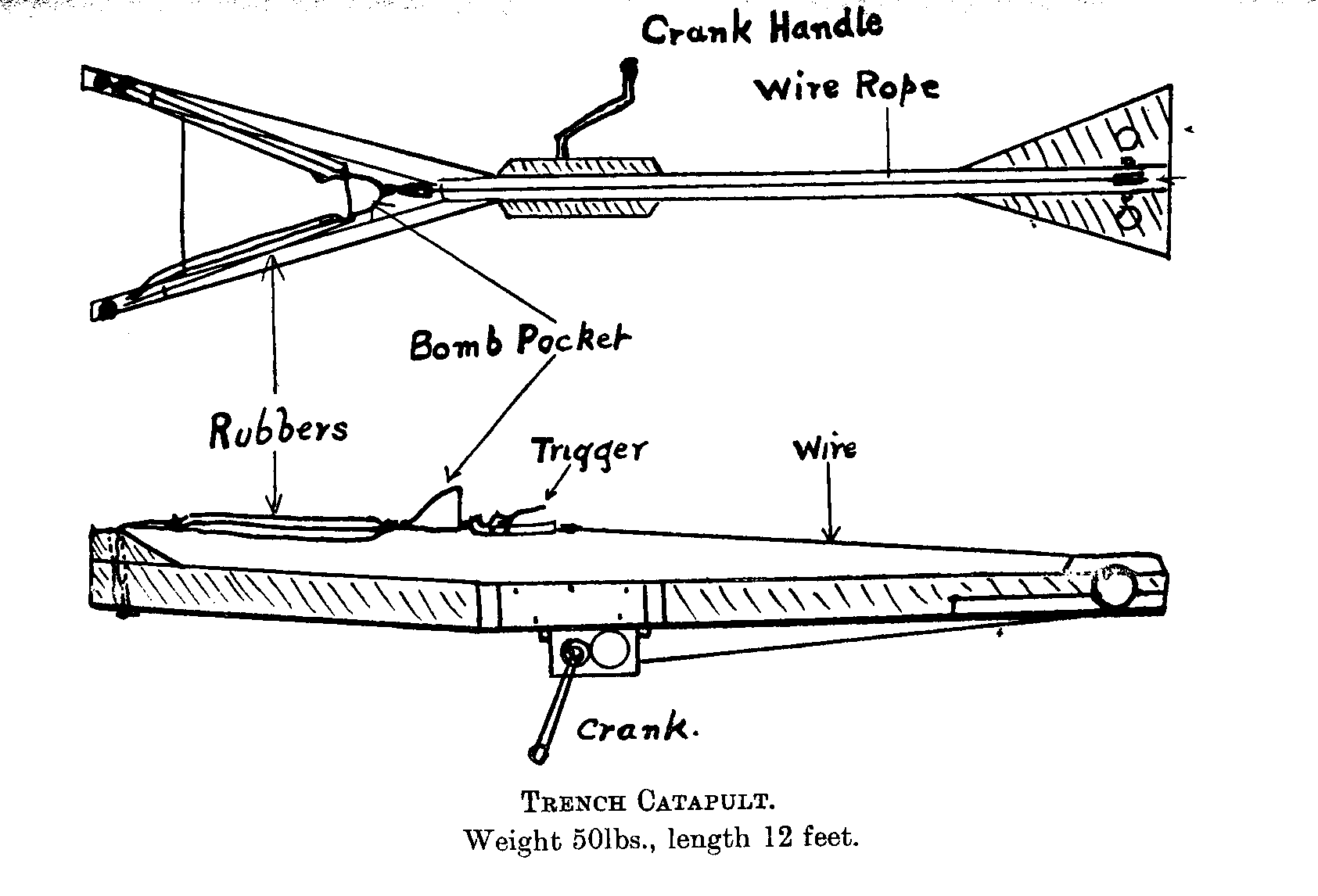
SPRING GUNS AND CATAPULTS
from Australian WW1 Manual on
Grenades and Their Uses
published "By Authority" Alfred J. Mullett,
Government Printer, Melbourne
Chapter 12: Trench
Catapault, as used in 1915
The above are used to throw bombs, and have the advantage that they can project these missiles at a greater distance
than is possible by hand. Any hand grenades or bombs way he thrown by these machines, but the larger the size the
shorter the range. These instruments are generally rather bulky, and require, very deep and comparatively wide
trenches. Special trenches require to be made to use these weapons. Such trenches are usually placed in rear of
the foremost firing line and to a flank of a communication trench. Although it seems a revision of the most primitive
methods of projection, there are certain advantages to be gained by such simple contrivances. The noise is small
compared with a gun or mortar, and for that reason, therefore, a certain amount of secrecy is obtainable, which
in itself is a considerable protection. There is no smoke, no flash, and nothing is visible, from the surface to
indicate the position of these weapons, and they could be easily screened from view from aeroplanes, their comparatively
small size making it practically impossible for them to be observed except at night, when the fuse may disclose
their position.
TRENCH CATAPULT.
This machine is simply an enlarged shanghai, the propelling force being due to rubber bands put in tension by means
of a rack-and-pinion gear, three to one, and piece of steel wire rope, about the thickness of an ordinary clothes
line, attached to a pocket which holds the grenade or bomb. The attachment to the pocket is composed of a clip
or hook with a releasing arrangement which acts as a trigger.he range of this weapon is determined by the tension
exerted on the rubber bands. A rough scale is provided an the centre beam of the catapult, marked aft only as a
guide. The elevation is arranged for by means of a small clinometer of very simple design placed on the side of
the central beam or bar.
The simplicity of this apparatus makes it difficult to describe, but reference to Plate XXI. will
show how primitive and simple the whole arrangement is.

The framework of the catapult is made of wood suitably screwed and bolted together, and it is 12 feet overall.
The rubber bands consist of i inch. circular rubberof the best quality, six or more in each bundle, there being
two bundles, one on either side of the pocket. The pocket for holding the grenade is made of canvas, with a rope
top. The rubber bands are secured to the catapult by means of cord, and the pocket is secured to the rubber bands
also by cord. The steel wire attached to the gear box pames over a pulley at the tail end of the catapult, and
is brought back to a brass gear box with two. pinions and an ordinary crank handle, the gear being, as already
stated, three to, one.
The catapult in use is elevated to the required elevation, and is held in position by means of sandbags, or may
be anchored by means of rope attached to a couple of screw-eyes provided for the purpose.
These catapults weight about 50 Ibs., and cost something about £12 a piece. They are fairly accurate, and
it is easy, with practice, to lob two out of three grenades in a 3-ft. trench at 120 yards distance.
The fuses used on the bombs have to be made variable to, suit the respective distances. It is stated that the pressure
that can be got up with this machine reaches 900 lbs. The machine is graduated up to 150 yards, but the figures
act as a guide only.
A range of 150 yards may be attained.